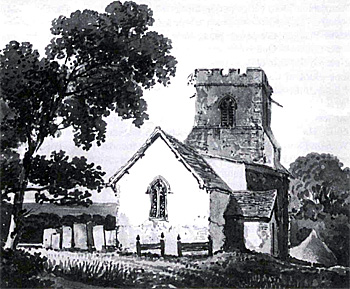John Schorne

The church from the west before the rebuilding of 1858-1860 - by George Shepherd in 1823
A History of Steppingley Church written in 1982 by Ampthill historian Andrew Underwood tells us of John Schorne: “John Schorne, rector from 1273 to 1282, was a man of considerable medical ability. His powers of healing were said to be outstanding to the extent of being miraculous. He was particularly accomplished at healing the ague, or malaria as we should call it, which was at that time very common in this country. He also appears to have had considerable success in curing such ailments as the gout, and it was a common belief that he had used his powers to imprison the devil in a boot, only permitting his head to appear out of the top”.
“On leaving Steppingley, John Schorne became rector of North Marston in Buckinghamshire. His fame spread to such an extent that for some two hundred years after his death pilgrims flocked to his tomb in North Marston church to seek healing and ease in their distress. When Saint George’s Chapel, Windsor, was built, Edward IV persuaded Pope Sixtus IV to allow him to remove these relics to a specially built chantry in the south-east corner of the building. A box was provided for the offerings of pilgrims, and small models of Schorne holding a boot with the devil’s head poking out, were sold as pilgrim tokens”.
In 1912 a hoard of five hundred silver coins dating to the 13th century was discovered in the church, as described in the history of the church referred to above: “Some were retained by the British Museum, some were sold at Sotheby’s, and a few found their way into the hands of workmen and villagers. A workman who was present when the discovery was made said the coins were contained in a knee-length boot: if this is so it adds greater significance to any speculation on the hoard’s connection with … John Schorne”. Another candidate is the absentee Italian rector Peter de Vitella, but as the hoard was reckoned to be deposited in or after 1268 this seems unlikely because, as far as is known, de Vitella was abroad for most of his time as rector.